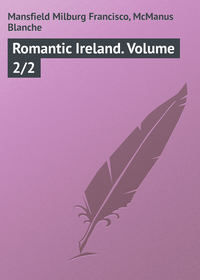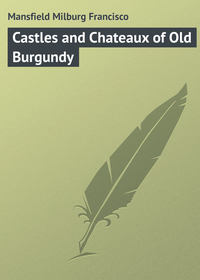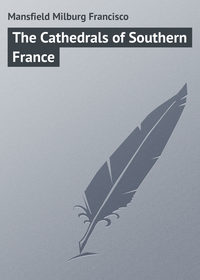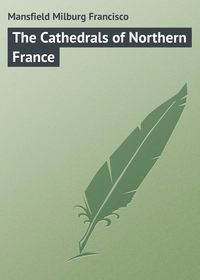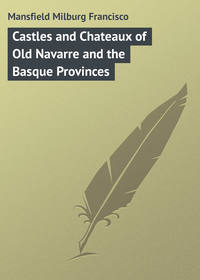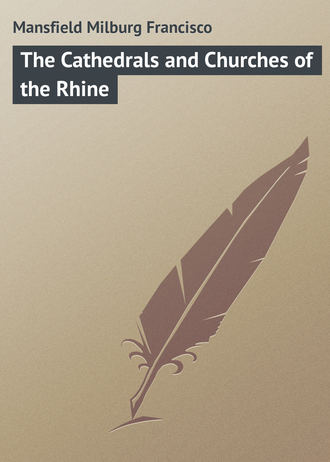 полная версия
полная версияThe Cathedrals and Churches of the Rhine
There are two other churches in Freiburg of more than usual interest; the parish church with a fine fourteenth-century cloister, and the Protestant temple, a modern structure in the Byzantine style, which has been built up on the remains of the church belonging to the ancient Benedictine convent of Tönnenbach, which existed in the twelfth century.
In the chapel of the university are a number of paintings by Holbein.
IX
STRASBURG
The greatest curiosity of Strasburg is the Rhine; after that, its cathedral.
Usually, on entering Strasburg, the first landmark that greets one's eye is the slim, lone spire of the cathedral.
Years ago an itinerant showman travelled about with a model of the celebrated Strasburg clock, and the writer got his first ideas of a great Continental cathedral from the rather crude representation of the Gothic beauties of that at Strasburg, which graced the canvas which hung before the showman's tent.
The clock is still there, in all its mystical incongruity, but one's interest centres in the grace and elegance of the dwindling spire and its substructure of nave, transept, and choir, which dominates all else round about.
Of many eras, the structure of this great Latin-cross cathedral is not harmonious; but, for all that, it is a great Gothic triumph, and one which might well lend most of its details of construction and decoration to any great church, and still add a charm which was hitherto absent.
Strasburg has in all fifteen churches, but the cathedral is possessed of more and greater glories than all the others combined.
From the days when Strasburg was the Argentoratum of the Romans, the city has ever been the scene of an activity which has made its importance known through all the world. It was sacked by Attila and his Huns in 451, and was completely abandoned up to the seventh century, when one of the sons of Clovis built it up anew and gave to it the name of Strateburgum.
Ptolemy is said to be the first writer who mentions Argentoratum, the ancient Strasburg.
What a bitter blow the loss of Alsace-Lorraine, of which Strasburg was the gem, was to France can only be realized by a contemplation of the sentiment which even yet attaches to the event.
That the allied provinces were French in spirit as well as Catholic in religion is demonstrated by the fact that, at the time of the German occupation, there was a population of over a million and a half of souls, of which quite a million and a quarter were of the Roman Catholic faith. About a million and a quarter were natives of Alsace-Lorraine, one hundred thousand were Germans, and thirty odd thousand were foreigners.
The present cathedral was erected on a site that had been consecrated to religion in very early times. It had been a sacred place in the time of the Romans, though the deities worshipped were pagan, a temple to Hercules and Mars having been erected here.
The first Christian church was built, it is believed, in the fifth century, by St. Amand, then Bishop of Strasburg.
This first church of Strasburg, which was a wooden structure, was probably founded by Clovis, 504, and reconstructed by Pepin-le-Bref and Charlemagne. It was mostly destroyed by fire in 873, and in 1002 was pillaged and fired anew by the soldiers of Duke Hermann, who was condemned himself to repair the damage. Lightning destroyed it again in 1007, and, by the time the new structure was thought of, nothing but the crypt of Charlemagne's edifice was visible.
From the proceeds received from Duke Hermann, and contributions from all Christianity, Bishop Werner conceived a vast scheme of a new church which in time was completed and consecrated.
This in turn fell before the ravages of fire, and nothing but a mass of débris remained, from which the present structure was begun in 1277.
The ancient church foundation of Strasburg was peculiarly arranged, after a manner most unusual in a cathedral church. The ground-plan of the ecclesiastical establishment was not unlike those of the monkish communities which were so plentifully scattered over Europe, but it was built for use as a church, and for the bishop and his clerics, instead of being merely a secular monastery.
The following diagram explains this unusual arrangement.
The masonic theory with regard to the construction of these mediæval ecclesiastical monuments is of much interest in connection with Strasburg. The lodge at Strasburg was the earliest in the north of which we have any knowledge, and Ervin von Steinbach himself seems to have been at the head of it, which fact proves that he was one of the first of secular architects engaged upon a great religious work.
Great opportunities and privileges were conferred upon him by Rudolph of Hapsburg, and the masonic lodge of which he was the head had the power, over a wide extent of territory, to maintain order and obedience among the workmen under its jurisdiction.
In 1278 Pope Nicholas III. issued a bull, giving the body absolution, and this was renewed by his successors up to the time of Benedict XII.
Iodoque Dotzinger, master of the works at Strasburg in 1452, formed an alliance between the different lodges of Germany.
It was an appreciative Frenchman – and all Frenchmen are appreciative and fond of Strasburg, because of what it once was to them – that said: "La cathédrale est un merveille unique au monde." Continuing, he said: "Those who have not seen it know not the gaieté lumineuse of a Gothic church."
All of this is of course quite true from some points of view.
There is, however, something pitiful about the general aspect of this great Gothic church. Its lone spire, standing grim and gaunt against a background of sky, makes only the more apparent the incompleteness of the structure.
Its façade is certainly marvellous, quite rivalling those of Reims and Toul, not so very far away across the French border.
The triple porch of the façade is rich in sculpture, the most remarkable groups being "The Wise and Foolish Virgins," "The Prophets," "The Last Judgment," and "Christ and the Twelve Apostles."
A great rose window, a reminiscence of the masterpieces so frequently seen in France, also decorates this elaborate façade.
The south portal is in the form of two round-arched doorways, and is a survival, evidently, of one of the earliest epochs of this style of construction. It is ornamented with bas-reliefs and statues symbolical of the triumph of Christian religion. There has recently been erected before this portal a statue of the great architect of the fabric, Ervin, and another of his son.
The spire, one of the most elevated in Europe, is 440 feet, while that of Cologne is 482 feet, Rouen is 458 feet, and Notre Dame at Paris but 200 feet in height.
Usually church edifices are grim and gray; but Strasburg presents, in its sandstone of the Vosges, a beautiful tone, which in the westering sun of a summer's day can only be described as a rose-pink, and is like no other church edifice in Europe, unless it be the cathedral at Rodez in Mid-France, which Henry James called mouse-coloured, but which in reality is a sort of warm, deep rose.
A fine lacework of colonnettes covers the entire façade, which six centuries have turned to the colour of iridescent copper organ-pipes.
But the real grandeur and dignity of the architecture stands out boldly in spite of the ornate turrets and the mass of sculptured detail, in a way which stamps the fabric imperially as a giant among its kind.
Of the spire, Victor Hugo wrote thus (Strasburg was yet French, and not German as it is to-day): "The truly adorable achievement of the builders of this cathedral is its spire. It is a tiara of stone crowned with a cross. It is prodigious, gigantic, but of great delicacy. I have seen Chartres; I have seen Antwerp. Four escaliers à jour ascend spirally the four towerlets at the angles. The steps are very high and narrow… To mount to the lantern one would have to follow the workmen, who appear to be continually engaged on the fabric. The stairways are no more, simply bars of iron set ladderlike in the masonry.
"From the spire one sees three mountain ranges: the group of the Black Forest to the north; the Vosges to the west; and the Alps to the south.
"One stands so high that the country-side appears no longer as the country-side; but, like the view from the castle at Heidelberg, a mere geographical map.
"At the time of my visit a great cloud rose up from the valley of the Rhine, and framed the panorama for a dozen leagues in truly eerie fashion. As I went from one tower to another, I saw about me la France, la Suisse, and l'Allemagne."
It was in 1277 that the celebrated architect, Ervin von Steinbach, began the construction of the portal of the cathedral at Strasburg, and above its great doorway one may yet read, if he be keen of eyesight and knows where to look for it, this inscription:
ANNO. DOMINI. MCCLXXVII. IN. DIEBEATIURBANI. HOC. GLORIOSUM. OPUSINCOHAVITMAGISTER. ERVINUS DE STEINBACHErvin died in 1318, and his son continued the work up to the first landing, or platform, of the towers.
In the archives of the cathedral are still to be seen the designs on which father and son worked in achieving the portal and towers, as well as those of the spire, the north porch, the pulpit, and the organ-buffet. Not all of these are contemporary, but the first, at least, are the very drawings which were handled by Maître Ervin and his son in the latter years of the thirteenth century.
The following lines of Longfellow describe the religious fervour of the great architect perhaps more truthfully than could prose.
".. A great master of his craft,Ervin von Steinbach; but not he alone,For many generations laboured with him,Children that came to see these saints in stone,As day by day out of the blocks they rose,Grew old and died, and still the work went on,And on and on and is not yet completed.".. The architectBuilt his great heart into these sculptured stones,And with him toiled his children, and their livesWere builded with his own into the wallsAs offerings to God."It is perhaps not possible to write of Strasburg's cathedral without giving its great clock more than a passing thought.
The legendary history of the clock at Strasburg is as follows:
The cathedral being terminated, the magistrates of the city desired to ornament its tower with a great clock which should be unique in all the world.
No one came forth to undertake the commission, until a workman, much advanced in years, agreed for a certain sum to produce a clock which should be superior to all others then existing.
After some years of incessant work, he produced the first of Strasburg's wonderful mechanical clocks full of moving figures and symbols.
In lieu of recompense, the magistrates, desiring that their city should be the sole possessor of such a work, accused the old man of having had resource to the aid of the devil in producing so weird a timepiece, and condemned him to torture and the loss of his eyesight.
Upon a pretext of making some further arrangement of the works before the execution of his sentence, the old man was allowed once more to mount the tower. Instead of adjusting the clock, he deranged it in some way so that its chimes never rang out as intended, and thus the magistrates and the citizens of Strasburg were, in a way, avenged for the injustice done the inventor. This famous clock of Strasburg's tower is now only a memory.
The more recent works of a similar nature have a history less sordid and unpleasant. The first clock of the cathedral, placed inside the church at the crossing, dated from 1352, and of course was a remarkable work for its time.
Two hundred years later it was intended to replace it with another, but the work was never achieved, so a third was begun with an effort to outdo the ingenuity which had made possible the fourteenth-century astronomical wonder.
It was planned in 1571, under the direction of Conrad Dasypodius, of Strasburg, and his friend Daniel Volkenstein, an astronomer of Augsburg. It was completed in 1574, restored in 1669 and 1732, and ceased its labours through the stress of time in 1790.
The present great clock, certainly an unseemly and incongruous adjunct of a great church, was commenced on the 24th of June, 1838, and installed on the 31st of December, 1842. Its construction is supposed to have reflected great credit upon its designer, one Schwilgu, a clock-maker of Strasburg. Nothing was preserved of the more ancient timepiece, except its elaborate case, which was restored and further embellished.
At the base of the tower, on the summit of which is placed the crowing cock, is a portrait of the designer. "This great man," say the local patriots, died an octogenarian in 1856.
In 1723 a subterranean tremor sent the tower of Strasburg's cathedral a foot out of plumb. It speaks well for the solidity of the construction that no ill effects resulted, and to-day there are no evidences, to the casual observer, of this deflection.
The beauty of Strasburg's cathedral was in so great repute in the middle ages that Jean Galeaz Marie, Visconti Sforza, in 1481, demanded of the magistrates of the city the name of an architect capable of completing his cathedral at Milan.
In a vaulted chamber attached to the cathedral proper are two strangely curious memorials. They are nothing more or less than two mummies which, for their better preservation, have been varnished, and the costumes which they anciently wore have from time to time been renewed.
One is the mummy of the Count of Nassau-Saarbruck, who died in the sixteenth century, and the other is that of a young girl of perhaps twenty years, supposed to have been his daughter.
The ancient church of St. Bartholomew is another of Strasburg's ecclesiastical shrines which ranks high among great churches.
It dates from the second half of the thirteenth century, but frequent additions have been made in more recent times.
It possesses a remarkable monument which shows a painted "Danse des Morts," with figures of nearly life size. It is a fresco on the inner walls of the overhanging canopy of a tomb. The painting dates from the fifteenth century, but was only discovered in 1824, on the occasion of a general renovation of the church.
The choir was begun in 1308 and completed in 1345. Its height and its general airiness, and the lightness of its vaulting and arches, unite in making it quite unusual and most worthy of note.
This ancient church to-day is occupied by the Protestants, and the edifice has been divided up in a somewhat sacrilegious manner in order to provide within its walls for a library and a museum.
Strasburg has another great church in St. Thomas, a vast ogival edifice which has some good glass, but which is remarkable above all else for the number of its sepulchral monuments, both ancient and modern.
At the end of the choir is found one of those wonders of French sculpture, an allegorical grouping of figures on the tomb of Maréchal de Saxe.
It was erected in 1777 by Pigalle by the order of Louis XV. For a background it has a pyramid of gray marble, at the base of which is the following inscription:
MAVRITIO SAXONICVRLANDIAE ET SEMIGALLIAE DVCISVMMO REGIORVM EXERCITVVMPRAEFECTOSEMPER VICTORILVDOVICVS XVVICTORIARVM AVCTOR ET IPSE DVXPONI IVSSITOBIIT XXX NOV. ANNO MDCCL. AETATISLVStanding in the centre of the pyramid is a figure of the maréchal descending toward the sarcophagus below. A figure representing Death is lifting the lid, and another, representing France, is endeavouring to stay his hand. Flags, a reversed torch, and other symbols, with another figure representing the genius of war, complete the details of this elaborate monument.
There is little of anything but Gothic, more or less pure, visible at Strasburg; but, in spite of this, it is alleged that, from Carlovingian times onward, there was here a colony of artisans who had been sent from Lombardy on account of the increased interest in the north in church-building. If this is so, they must have pushed onward down the Rhine, as they left but little impression here, and, while Rhenish church-building was manifestly not Gothic in its inception, here at Strasburg there are certainly no evidences of the Comacine builders of Charlemagne's time.
Strasburg's ancient episcopal palace was built in 1731-41 by Cardinal de Rohan. It was bought by the city before the Revolution and transformed into a château impérial, and became later the home of the local university.
The edifice known in early days as the "Maison de l'Oeuvre Notre Dame," and more recently as "Stift zu unser lieben Frauen," was built in 1581, numerous Gothic sculptures from the cathedral being used in its construction. There is here a remarkable spiral staircase in the light and delicate flowered Gothic of its time.
X
METZ
From across the Moselle, on the height just to the south of the city of Metz, is to be had one of those widely spread panoramas which defy the artist or the photographer to reproduce.
There is an old French saying that the Rhine had power; the Rhône impetuosity; the Loire nobility; and the Moselle elegance and grace. This last is well shown in the charming river-bottom which spreads itself about the ancient Mediomatricorum, as Metz was known to the Romans.
The enormously tall nave and transepts of the cathedral of Metz dominate every other structure in the city, in a fashion quite in keeping with the strategic importance of the place from a military point of view.
Time was when ecclesiastical affairs and military matters were much more closely allied than now, and certainly if there was any inspiration to be got from a highly impressive religious monument in their midst, the warriors of another day, at Metz, must have felt that they were doubly blessed.
Since the Franco-Prussian war, Metz, with Strasburg, has become transformed; but its ancient monuments still exist to charm and gratify the antiquarian. Indeed, it was as recently as 1900 that the Tour des Lennyers, a wonderful structure of Roman times, was discovered.
Metz was fortified as early as in the third century, and to-day its walls and moats, though modern, – the work of Vauban, – are still wonders of their kind.
In the Roman period the city was of great importance. In the fifth century it was attacked, taken, and destroyed by the Huns; but, when it was rebuilt and became the capital of Austrasia, its prosperity grew rapidly. In 1552 the Due de Montmorenci made himself master of the city, and some months later Henri II. made his entrée. During the winter of the same year it successfully resisted Charles V., thanks to François de Lorraine and the Duc de Guise.
The great abbey of St. Arnulphe disappeared at this time. It stood on the site of the present railroad station, where, in 1902, were found many fragments of religious sculptures, coming presumably from the old abbey.
In 1556-62 the citadel was constructed by Maréchal Vielleville. Within the citadel was the old church of St. Pierre, one of those minor works of great beauty which are often overlooked when summing up the treasures of a cathedral town. The old church dated originally from the seventh century, though reconstructed anew in the tenth, and again in the fifteenth century.
The walls of the surrounding fortifications are of incontestable antiquity. Beneath the pavement of the chapel have recently been found fragments of sculptured stone dating from Merovingian times.
It was during a dangerous illness at Metz that Louis XV. is said to have made the vow which led to the erection of that pagan-looking structure, the church of Sainte Genéviève, more commonly known as the Pantheon, at Paris. It is the largest modern church in France, if, indeed, one can really consider it to-day as a church.
Metz, before its annexation by Germany, was as French as Reims or Troyes. Many of the natives of the city have since left, but they have been replaced by Germans, so the population has not suffered in numbers.
Of a population of forty-five thousand, there are twenty-four thousand soldiers. Hotels, shops, and cafés have become Germanized, but, curiously enough, many, if not nearly all, of the cab-drivers speak French, and French money passes current everywhere.
Certain restaurants preserve what they call the traditions de la cuisine française, and in the municipal theatre a company of French players come from Nancy three times a week in the winter season.
Metz, one of the three ancient bishoprics of imperial Lorraine, now forms a part of Elsass-Lothringen, where the German Emperor reigns as emperor and not merely as King of Prussia.
The churches of Metz show very little of Romanesque influences, though it is indeed strong in churches dating from the thirteenth century onward. Early Gothic in nearly every shade of excellence is to be found in the churches of Metz, from the cathedral church of St. Stephen downwards, and, because of this, it is the Continental city where the development of the style can be most thoroughly studied and appreciated.
In many cases there are only fragments, at least, that which is to be admired is more or less fragmentary; but, in spite of that, they are none the less precious and valuable as a record.
Besides its churches, Metz has, in its ancient donjon or castle-keep, a singularly impressive monument of its past greatness, which stands in the Geisbergstrasse, or the Rue de Chèvremont, as the street is called by the French, for Metz, like Strasburg and the other cities and towns of poor rent Alsace and Lorraine, is even yet a muddle of French and German proper names.
This great pile was doubtless the former royal shelter of Theodoric and others of his line.
To-day Metz is mostly a city of strategic fortifications; but this is but one aspect, and the seat of the renowned bishopric of Lorraine has in its cathedral church an ecclesiastical monument of almost supreme rank.
St. Stephen's Cathedral is a vast structure of quaint and almost grotesque outline, when seen from across the Moselle. Its chief distinction, at first glance, is its height, which seems to dwarf all its other proportions; but in reality it is attenuated in none of its dimensions, and its clerestory is hugely impressive, where one so often finds this feature a mere range of shallow windows.
Among the great churches of Northern Europe, the cathedral of St. Stephen stands third, it being surpassed only by the cathedrals of Beauvais and Cologne.
This fact is frequently overlooked, and ordinarily Metz would be classed with that secondary group which includes Reims, Bourges, and Narbonne; but so accurate an authority as Professor Freeman vouches for the statement.
The clerestory, of a prodigious height, is borne aloft by a series of rather squat-looking pillars, but again figures demonstrate that the cathedral at Metz is truly one of the wonders of its kind.
There is a north tower which is, or was, a part of the civic establishment as well, in that it contained an alarm-bell, similar to those employed in the Netherlands, known as La Mutte. Twin towerlets straddle the nave of the cathedral in a quite unexplainable manner.
Altogether the building has a most remarkable and not wholly beautiful sky-line, to which one must become accustomed before it is wholly loved.
Decidedly the least likable portion of the exterior of St. Stephen's is the west front, which is decidedly incongruous, whereas in most places it is the west front that shines and is truly brilliant. Certainly, in this respect Metz does not follow that French tradition which, in its Gothic churches, it otherwise obeys.
St. Stephen's really rises to almost a supreme height. It has been said to exceed that of Amiens and Beauvais, but this is manifestly not so, for, if the figures are correct, it is some seven feet lower than Amiens and twenty lower than Beauvais. Still, it rises to a daring height, and its "walls of glass," with their enormously tall clerestory windows, only accentuate its airiness and grace.
This last quality is remarkable in Gothic architecture of so early a period, the thirteenth century. At St. Ouen at Rouen, to which its openness may be compared, and perhaps to Gloucester in England, the work is of a much later date.
The interior of St. Stephen's presents an equally marked effect of height and brilliancy, with perhaps an exaggeration of the ample clerestory at the expense of the triforium.



